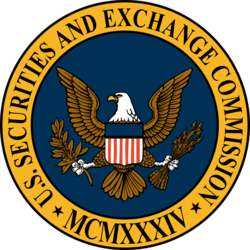Difference between revisions of "U.S. Securities and Exchange Commission"
m (Text replacement - " great depression" to " great depression") |
|||
| Line 13: | Line 13: | ||
}} | }} | ||
| − | The '''U.S. Securities and Exchange Commission''' (SEC) is a regulatory agency of the [[US federal government]], created after the great depression by the [[Securities Exchange Act of 1934]]. | + | The '''U.S. Securities and Exchange Commission''' (SEC) is a regulatory agency of the [[US federal government]], created after the [[great depression]] by the [[Securities Exchange Act of 1934]]. |
Revision as of 13:15, 5 September 2016
 | |
| Formation | June 6, 1934 |
| Parent organization | US |
| Status | captured |
| Headquarters | Washington, D.C. |
| Leader | U.S. Securities and Exchange Commission/Chair |
| Type | |
| Staff | 3,958 |
| Subpage | •U.S. Securities and Exchange Commission/Chair |
| The US government's agency to regulate the financial sector, generally thought to be completely captured by the larger financial interests. | |
The U.S. Securities and Exchange Commission (SEC) is a regulatory agency of the US federal government, created after the great depression by the Securities Exchange Act of 1934.
'Lost' records
Zapata Oil's records from 1960-1966 are missing. Wison Carpenter, a record analyst with the SEC reports that these were destroyed in 1981, shortly after George H. W. Bush became Vice President of the United States. This would appear to parallel the destruction of the CIA records about his early service with that organisation. After Jonathan Kwitny unearthed duplicate copies elsewhere, Bush admitted through a spokesman a brief business relationship with Jorge Diaz Serrano, which he claimed lasted just 7 months, yet which the duplicate SEC filings made clear in fact lasted 4 years. They also established that the relationship involved both breaking Mexican law and keeping US shareholders in the dark about the deal - a violation of US law.[1]
Regulatory Capture
The SEC is cited as a canonical example of regulatory capture, as suggested by the revolving door between the financial service sector and the SEC. Numerous frustrated mid level officials have testified to its ineffectual nature.
Securities and Exchange Commission prosecuting attorney, James Kidney, was widely cheered at his retirement party on March 27th, 2014 when he noted that his prosecutions of Goldman Sachs and other mega-banks had been nixed by the agency's higher level staff, because they "were more focused on getting high-paying jobs after their government service than on bringing difficult cases."[2]
9/11 Connection
In September 2001, 7 World Trade Center housed the files relating to approximately 3,000 to 4,000 ongoing SEC cases. Wikipedia asserts that "Although some were backed up elsewhere, others were not, especially those classified as confidential." The 9/11 attacks therefore provided an excuse for any cases inconvenient or displeasing to SEC management to be immediately dropped. Files relating to Citigroup's connection to the WorldCom scandal were lost.[3]
Related Quotation
| Page | Quote | Author | Date |
|---|---|---|---|
| Regulatory capture | “Probably most people would agree that the people paid by the U.S. government to regulate Wall Street have had their difficulties. Most people would probably also agree on two reasons those difficulties seem only to be growing: an ever-more complex financial system that regulators must have explained to them by the financiers who create it, and the ever-more common practice among regulators of leaving their government jobs for much higher paying jobs at the very banks they were once meant to regulate. Wall Street's regulators are people who are paid by Wall Street to accept Wall Street's explanations of itself, and who have little ability to defend themselves from those explanations.” | Michael Lewis | September 2014 |
References
- ↑ Jonathan Kwitny, "The Mexican Connection: A look at an old George Bush business venture", Barron's September 19, 1988. Cited with further discussion by Russ Baker, Family of Secrets (New York: Bloomsbury Press, 2009) pp. 37 and 505.
- ↑ http://www.counterpunch.org/2014/04/09/65578/
- ↑
{{URL|example.com|optional display text}}